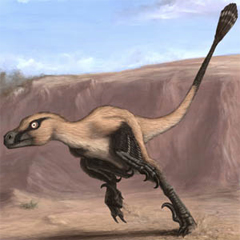
A research student partly funded by the Geological Society has discovered a new species of dinosaur in Inner Mongolia, closely related to the famous Velociraptor, reports Sarah Day
Geoscientist Online 19 March 2010
Michael Pittman, a doctoral student at University College London (UCL) and Jonah Choiniere, a doctoral candidate at George Washington University, came across a spectacular find buried in red sandstone rocks approximately 75 million years old during an expedition carried out as part of the Inner Mongolia Research Project in 2008.
“I only saw the tip of the claw sticking out of a cliff face”, says Choiniere. “It was a total surprise that the whole skeleton was buried deeper in the rock”. What they had found was a nearly complete, exceptionally well preserved skeleton of a relative of the infamous predator Velociraptor.
“Jonah saw a claw protruding from the cliff face”, Pittman told Geoscientist. “He carefully removed it and handed it to me. We went through its features silently but he wanted my identification first. I told him it was from a carnivorous dinosaur and when he agreed I'm surprised nobody in London heard us shouting!”
The dinosaur has been named Linheraptor exquisitus. At approximately 2.5 metres long and weighing 25kg in life, the researchers believe it would have been a fast, agile predator preying on small horned dinosaurs related to Triceratops. The artist's impression depicts the dinosaur covered in primitive feathers.
The find is important in understanding the evolution of the Dromaeosauridae, a family of bird-like theropod dinosaurs that lived during the Jurassic and Cretaceous Periods. As well as Linheraptor and Velociraptor, theropod dinosaurs include Tyrannosaurus rex - and modern birds.
Prof Xu Xing of the Chinese Academy of Sciences' Institute of Vertebrate Paleontology and Paleoanthropology, and an Honorary Fellow of the Geological Society, led the research. He told Geoscientist: “This is a really beautiful fossil and it documents a transitional stage in dromaeosaurid evolution”.
The Inner Mongolia Research project aims to better understand the Late Cretaceous ecosystem of Inner Mongolia, China. Michael Pittman's is researching the evolution and biomechanics of dinosaurs at UCL, and is the recipient of a Geological Society research grant.
“The Society has this great resource, funding fieldwork” says Pitman. “The money I got was specifically for outdoor fieldwork, and funded my participation in the project. Without it, I wouldn’t have been able to go.”
He talks about his discovery in the video below: